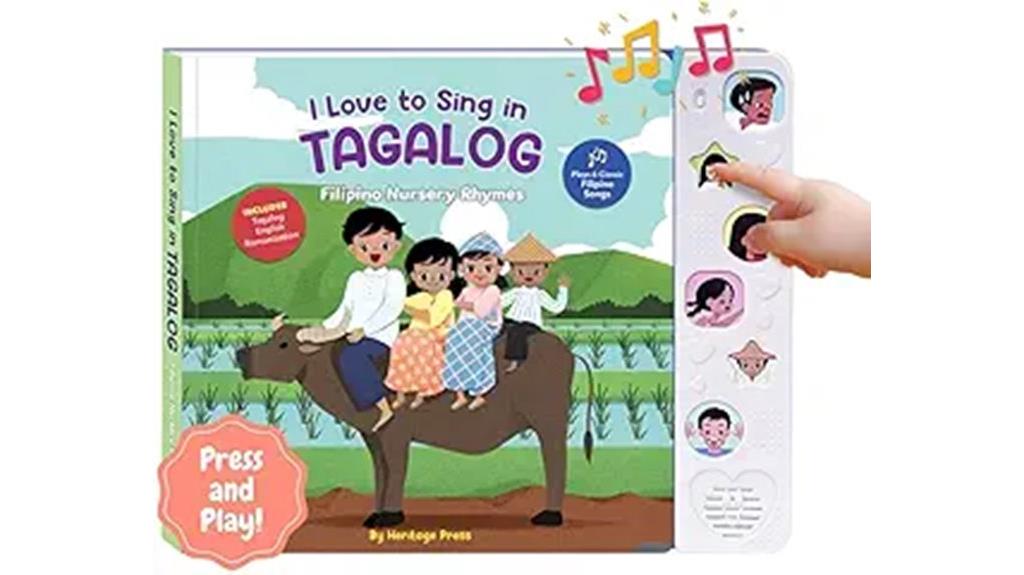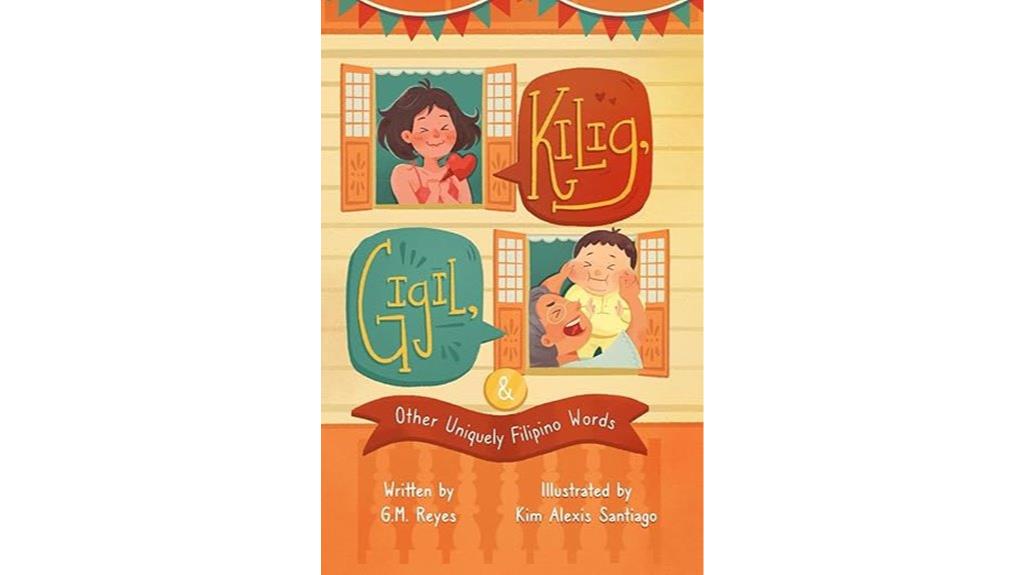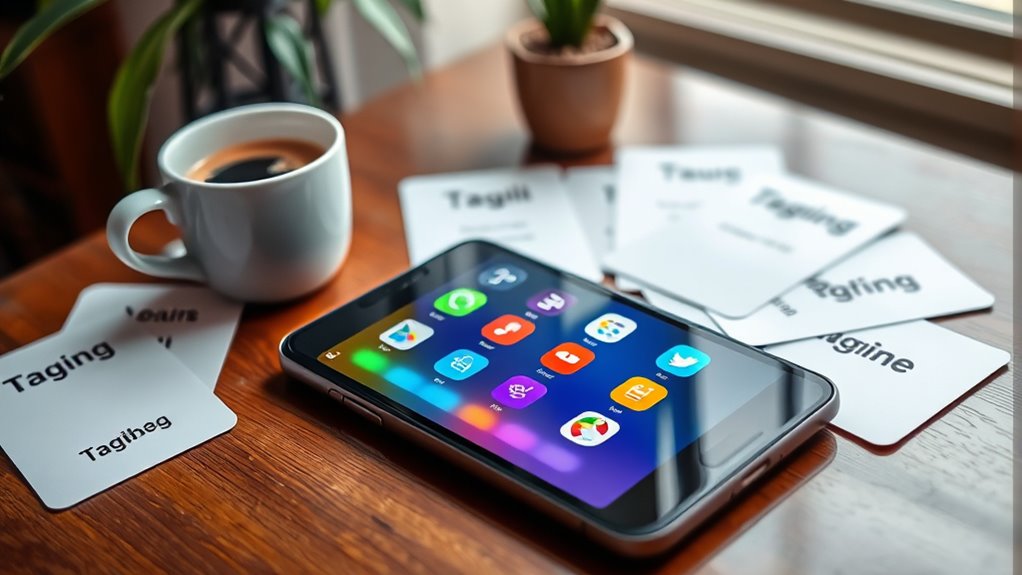If you’re looking to master Tagalog quickly, I recommend exploring a mix of engaging books and innovative apps. “Tagalog Books for Kids” series offers fun ways to learn through music and stories, while devices like the Timekettle W4 Pro earbuds provide instant translation support. Don’t forget about interactive apps that track your progress and enhance your learning experience. There’s so much more to discover that can make your journey enjoyable and effective, so keep discovering!
Key Takeaways
- Look for apps with user-friendly interfaces and cultural relevance to enhance engagement and understanding of Tagalog.
- Choose apps that support diverse dialects and offer interactive features like quizzes and games for a fun learning experience.
- Consider financial options, including free tiers and one-time purchases, to find a suitable budget for long-term learning.
- Ensure apps provide offline accessibility for flexible study and uninterrupted learning, especially for travelers.
- Seek apps with robust progress tracking to monitor improvements in vocabulary, grammar, and pronunciation accuracy.
Tagalog Books for Kids Vol. 1: Songs in Tagalog & English

If you’re looking for a fun and effective way to introduce your little ones to Tagalog, “Tagalog Books for Kids Vol. 1: Songs in Tagalog & English” is an excellent choice. I love how these bilingual books feature classic Filipino children’s songs, sung by a real mom in a soothing voice. The sturdy, non-tearing pages are perfect for little hands. My kids enjoy the interactive audio, and I appreciate the volume controls and mute options. Plus, the engaging illustrations make learning Tagalog feel like play. It’s a fantastic resource for nurturing language skills and cultural connections in our family!
Best For: Parents seeking an engaging and educational resource to introduce their young children to the Tagalog language and Filipino culture.
Pros:
- High-quality audio featuring a soothing voice that makes learning enjoyable.
- Durable, non-tearing pages designed for toddlers and young children.
- Interactive features like volume controls and mute options enhance user experience.
Cons:
- Limited to classic songs, which may not appeal to all children’s musical tastes.
- May require batteries, which could be an inconvenience for some parents.
- The focus on songs might limit exposure to more comprehensive language learning materials.
Instant Translator Device Supports 52 Languages

The Instant Translator device, supporting 52 languages, is perfect for travelers and language enthusiasts alike. I love how compact it is; it easily fits in my pocket. With modes for face-to-face conversations, picture translations, and recordings, it’s versatile for any situation. The high sensitivity speaker captures speech well, and I appreciate that it displays translations on my phone. While some users reported compatibility issues, I found it worked seamlessly after connecting via Bluetooth and downloading the app. Overall, it’s an affordable tool to help me learn Tagalog and practice pronunciation, making my language journey much smoother.
Best For: Travelers and language enthusiasts looking for a compact and versatile translation tool.
Pros:
- Supports 52 languages, making it suitable for various communication needs.
- Compact design allows for easy portability in pockets or wallets.
- Multiple translation modes, including face-to-face and picture translation, enhance usability.
Cons:
- Some users reported compatibility issues with specific devices.
- Mixed reviews regarding effectiveness for certain language pairs.
- Setup and functionality may pose challenges for some users, leading to potential returns.
Tagalog Books for Kids Vol. 1: Tin Tin Learns Tagalog

For parents looking to introduce their little ones to the Tagalog language, “Tagalog Books for Kids Vol. 1: Tin Tin Learns Tagalog” is a fantastic choice. This bilingual board book features engaging songs like “Maliit Na Gagamba” and “Twinkle Twinkle Little Star,” sung by a real mom in a soothing voice. The sturdy, non-tearing pages are perfect for toddlers, and the built-in audio makes learning fun! I love how it supports early education with flashcards and workbooks. Many parents rave about its quality and effectiveness. It’s a must-have for any family wanting their child to connect with Filipino culture.
Best For: Families looking to introduce their young children to the Tagalog language and culture through engaging and interactive bilingual books.
Pros:
- High-quality audio featuring a soothing voice that enhances language learning.
- Durable, non-tearing board book pages ideal for toddlers.
- Includes engaging songs and additional educational tools like flashcards and workbooks.
Cons:
- Limited to classic Tagalog children’s songs, which may not appeal to all kids.
- Requires batteries, which may need to be replaced over time.
- Some parents may find the audio volume controls insufficient for quiet environments.
Tagalog Books for Kids Vol. 2: Tin Tin Learns Tagalog

Perfect for young learners, “Tagalog Books for Kids Vol. 2: Tin Tin Learns Tagalog” offers a delightful way for babies and toddlers to engage with the Filipino language. This beautifully designed board book features non-tearing pages and includes batteries for sound functionality. I love how it offers classic Tagalog songs sung by a real mom, making it soothing and relatable for kids. The side-by-side translations help both children and parents bond over music and storytelling. With flashcards and workbooks included, it’s a fantastic resource for teaching basic vocabulary and phrases, making language learning enjoyable for everyone involved.
Best For: Babies, toddlers, and children who are beginning to learn Tagalog in a fun and engaging way.
Pros:
- The book features non-tearing board pages, making it durable for young readers.
- Includes classic Tagalog songs sung by a real mom, providing a soothing audio experience.
- Offers side-by-side translations and interactive learning tools like flashcards and workbooks.
Cons:
- The reliance on batteries for sound functionality may require regular maintenance or replacements.
- Limited to Tagalog songs and may not cover a wide range of vocabulary beyond basic phrases.
- Some parents may find the audio volume controls insufficient for varying environments.
I Love to Sing in Tagalog: Interactive Song Book for Toddlers

If you’re looking to introduce your little ones to the joys of learning Tagalog, “I Love to Sing in Tagalog: Interactive Song Book for Toddlers” is an excellent choice. With its catchy tunes and vibrant illustrations, this book makes learning Tagalog fun and engaging. The rhythmic songs help expand vocabulary while simple narratives support early comprehension. I love how it combines cultural elements, fostering family bonding through shared singing moments. Plus, the durable board book format and pronunciation guides guarantee a great user experience. It’s become a favorite in our home, making language learning a delightful adventure for my kids!
Best For: Families looking to introduce toddlers to the Tagalog language and Filipino culture through music and interactive learning.
Pros:
- Interactive songs enhance vocabulary retention and language skills in a fun way.
- Bright illustrations and cultural elements promote engagement and family bonding.
- Durable board book format and pronunciation guides ensure a user-friendly experience.
Cons:
- Limited to Tagalog songs, which may not appeal to families interested in other languages.
- Some toddlers may need adult assistance to navigate the interactive features.
- The book may require batteries for sound, adding a maintenance consideration.
Timekettle X1 AI Interpreter Hub and Translator Earbud

The Timekettle X1 AI Interpreter Hub and Translator Earbud stands out as an excellent choice for language learners who often engage in real-time conversations or attend multilingual meetings. With support for 40 languages and the ability to handle up to 20 participants, it’s perfect for group settings. The bidirectional simultaneous translation is impressive, especially for one-on-one chats. However, I’ve found the translation quality can be hit or miss, sometimes lacking coherence. Plus, the battery life might not last through long sessions. Despite its bulky design, I appreciate its intuitive interface; it’s a useful tool for mastering Tagalog in dynamic environments.
Best For: Language learners and professionals who frequently participate in real-time multilingual conversations and meetings.
Pros:
- High-quality hardware with an intuitive user interface for seamless operation.
- Supports bidirectional simultaneous translation, making it ideal for one-on-one discussions and group settings.
- Media translation capability enhances the experience for foreign videos and online meetings.
Cons:
- Translation quality can be inconsistent, sometimes lacking coherence and context.
- Bulky design limits portability and may hinder usability during conference calls.
- Earbud battery life may not be sufficient for extended use, leading to potential interruptions.
Timekettle W4 Pro AI Interpreter Earbuds for Translation

For anyone diving into Filipino language learning, the Timekettle W4 Pro AI Interpreter Earbuds stand out as an essential tool, especially given their support for 40 languages and 93 accents. I love how they allow for bi-directional simultaneous translation, making conversations seamless. The dual-channel feature really shines, letting both parties speak freely. Plus, the triple mic noise reduction guarantees clarity, even in busy places. With up to 300 minutes of media translation each month, they’re perfect for daily practice. While I’ve encountered some hiccups in noisy settings, their overall performance makes them a valuable asset for mastering Tagalog quickly.
Best For: The Timekettle W4 Pro AI Interpreter Earbuds are best for language learners and travelers needing reliable translation support in various environments.
Pros:
- Supports 40 languages and 93 accents for versatile communication.
- Bi-directional simultaneous translation allows seamless conversations between speakers.
- Triple mic noise reduction enhances clarity even in noisy settings.
Cons:
- Performance can suffer in group settings and very noisy environments.
- Requires an iPhone to function and may experience significant battery drain.
- Limited effectiveness in specific language pairs, leading to occasional inaccuracies.
AI Translation Earbuds with 144 Languages Translator

Looking to enhance your Filipino language learning experience? The AI Translation Earbuds are a game-changer with real-time translation in 144 languages, including Tagalog. Weighing just 1.54 ounces, they’re lightweight and designed for comfort, making them perfect for long wear. With 99% accuracy and a response time of less than 0.2 seconds, I found them reliable for basic conversations. Plus, they don’t require a subscription and easily connect to iOS or Android. While they have limitations, like mixed audio quality, they offer a unique way to practice Filipino in everyday situations.
Best For: Language learners and travelers seeking a convenient and efficient way to communicate in multiple languages, including Tagalog.
Pros:
- Lightweight and comfortable design, ideal for long-term wear.
- Real-time translation with 99% accuracy, enhancing communication.
- Compatible with both iOS and Android devices without requiring a subscription.
Cons:
- Mixed audio quality, especially for music playback, compared to other earbuds.
- Some users experience confusion with the app interface and initial connection issues.
- Limitations in handling complex translations, particularly with punctuation and intonation.
Kilig, Gigil & Other Uniquely Filipino Words: A Rhyming Book About Unique Tagalog Words

Uncovering the beauty of the Filipino language can be a delightful journey, especially with “Kilig, Gigil & Other Uniquely Filipino Words.” This rhyming book captivates children and adults alike, making it a fantastic choice for families enthusiastic to explore their cultural roots together. The playful illustrations enhance the learning experience, making it easier to remember unique Tagalog words. I’ve found it engaging for toddlers and teens, and even those who are kids at heart enjoy it! Parents rave about its educational value, and I can’t recommend it enough for anyone wanting to connect with Filipino heritage in a fun way.
Best For: Families looking to explore Filipino heritage and language together in a fun and engaging way.
Pros:
- Engaging rhyming format makes learning fun for both kids and adults.
- Cute illustrations enhance the reading experience and aid in memory retention.
- Highly recommended by parents for its educational value and cultural connection.
Cons:
- Limited to Filipino culture, which may not appeal to those outside of the heritage.
- Younger children may require parental guidance to fully understand some concepts.
- Availability may be restricted in certain regions or bookstores.
Factors to Consider When Choosing Filipino Language Learning Apps

When choosing a Filipino language learning app, I think about several key factors that can really make a difference. User-friendliness and interactive features are important, as they keep me engaged and motivated. Plus, I always consider the app’s cultural relevance and cost, since these elements can enhance my learning experience.
User-Friendliness and Navigation
Choosing a Filipino language learning app can be overwhelming, especially with so many options available. I’ve found that user-friendliness is essential for a smooth learning experience. Look for apps with intuitive interfaces that let you navigate lessons without any confusion. Clear categorization of content—like vocabulary, grammar, and cultural notes—makes it easy to find what you need. I appreciate interactive elements such as quizzes and games that are simple to access. Visual aids and audio prompts also help by providing immediate feedback, especially for pronunciation. Finally, don’t underestimate the importance of regular updates and user support; these features guarantee you’re getting the best experience possible and help when you hit a snag.
Language Variety and Coverage
How well does the app address the diverse linguistic landscape of the Philippines? When choosing a Filipino language learning app, I always check how many dialects and variations it supports. With over 175 languages, Tagalog is just the tip of the iceberg. I look for apps that provide extensive vocabulary and phrases for different contexts—whether conversational, formal, or cultural. It’s essential for the app to include regional accents and colloquialisms, as these greatly impact pronunciation and understanding. I also appreciate a balance of written, audio, and visual content, which caters to various learning styles. This way, I can enhance my language skills effectively and prepare for real-world interactions.
Interactive Learning Features
Interactive learning features can make a world of difference in mastering the Filipino language. I’ve found that gamified exercises and quizzes really boost my engagement and help me retain vocabulary and grammar structures better. Audio pronunciation guides and catchy songs are also fantastic for developing my listening and speaking skills in a fun way. Real-time feedback, like instant corrections on quizzes, is invaluable; it shows me where I can improve while reinforcing what I’ve learned. I love the variety of resources, from flashcards to storybooks, which deepen my connection to the language. Also, social interaction features, like language exchange and community forums, give me the chance to practice speaking with native speakers, enhancing my conversational skills.
Cultural Relevance and Engagement
When I immerse myself in a Filipino language learning app, I’m always on the lookout for content that resonates with the culture. Engaging with songs and stories not only enhances my language retention but also deepens my connection to Filipino heritage. I appreciate apps that incorporate traditional narratives and rhymes, as they help me grasp the cultural nuances unique to the language. Visual elements, like illustrations of Filipino customs, make learning more enjoyable and relatable. Furthermore, interactive features that promote shared activities, such as singing or storytelling, encourage family bonding and active participation. This exposure to Filipino traditions sparks my interest in exploring and appreciating the rich culture behind the language, making my learning journey even more rewarding.
Cost and Subscription Options
Choosing the right Filipino language learning app can be overwhelming, especially with so many options available. When considering costs, I’ve found that many apps offer a free tier, but premium features typically require a subscription ranging from $5 to $20 per month. I recommend looking for apps that provide a one-time purchase option if you’re a long-term learner; it can save you money in the long run. Some apps even offer discounts for annual subscriptions, which is a smart choice for committed learners. Don’t forget to check the trial period; it’s a great way to see if the app suits your needs before making a financial commitment. Keep an eye out for any additional costs, like in-app purchases, too.
Progress Tracking Capabilities
Many learners find that progress tracking capabilities are essential when selecting a Filipino language learning app. I appreciate apps that let me monitor my language skills over time, as it provides valuable insights into areas where I need improvement. Features like gamification, where I can earn points or badges for completing lessons, really motivate me to stay engaged. Metrics like vocabulary acquisition, grammar mastery, and pronunciation accuracy help me focus on specific learning goals. I also look for personalized feedback based on my progress, which tailors my learning experience. Regular assessments or quizzes serve as benchmarks, allowing me to measure my progress and celebrate milestones effectively. These features make my learning journey more rewarding and structured.
Offline Accessibility and Support
Having tracked my progress in Filipino language learning, I’ve realized that offline accessibility is another key factor to take into account in an app. I love the freedom of studying without needing a stable internet connection. Apps that allow me to download vocabulary lists and lessons really enhance my learning flexibility, especially since I sometimes find myself in areas with spotty internet. Features like offline practice exercises and quizzes are also invaluable for reinforcing my skills on the go. However, I always check how much content is available offline, as some apps offer limited resources. If you travel frequently or face inconsistent internet service, prioritizing apps with strong offline support will guarantee uninterrupted learning opportunities.
Frequently Asked Questions
Are These Apps Suitable for Absolute Beginners in Tagalog?
When I started learning Tagalog, I found that many apps catered specifically to absolute beginners like me. They break down the basics, offer interactive lessons, and build vocabulary gradually. I appreciated the user-friendly interfaces and engaging exercises that made learning fun. Plus, they often include audio pronunciations, which helped me with pronunciation. So, if you’re starting from scratch, these apps can be a fantastic way to immerse yourself in Tagalog.
Do the Apps Include Audio Pronunciation Features?
Did you know that over 80 million people speak Tagalog? I’ve found that many language learning apps do include audio pronunciation features, which are essential for mastering any language. These features let you hear native speakers pronounce words and phrases, helping you improve your accent and understanding. I always recommend using these features because they make learning more engaging and effective. Trust me, you’ll notice a difference in your confidence!
Can I Use These Apps Offline?
Absolutely, I’ve found that many language learning apps offer offline capabilities. When I download the lessons or resources, I can access them anytime, even without an internet connection. It’s super convenient, especially when I’m traveling or in areas with poor connectivity. I love being able to practice my Tagalog on the go, whether I’m on a bus or enjoying a quiet moment at home. Just check the app’s features to guarantee offline access!
Are There Any Age Restrictions for Using These Apps?
Are you worried about age restrictions when using language learning apps? I understand your concern! Most of these apps don’t have strict age limits, but they often cater to a wide audience, from kids to adults. I’ve seen features like parental controls to guarantee a safe environment for younger users. It’s always a good idea to check the app’s guidelines, just to be certain it fits your age group and learning style perfectly!
How Do I Track My Progress While Learning Tagalog?
Tracking my progress while learning Tagalog has been a game-changer. I use a simple journal to jot down new words and phrases I master each week. I also take regular quizzes on my learning app, which helps me see where I stand. Setting goals, like holding a short conversation, keeps me motivated. Plus, I celebrate my milestones, no matter how small, which makes the journey enjoyable and fulfilling.
Conclusion
In my quest to master Tagalog, I’ve discovered that the right tools can make all the difference—like a trusty smartphone in a world of typewriters! Whether it’s interactive books, AI translation earbuds, or engaging apps, each resource offers a unique way to immerse oneself in the language. So, if you’re ready to embrace the beauty of Filipino culture, don’t hesitate to explore these apps. Your journey to fluency can be fun and fulfilling, just like a karaoke night with friends!









